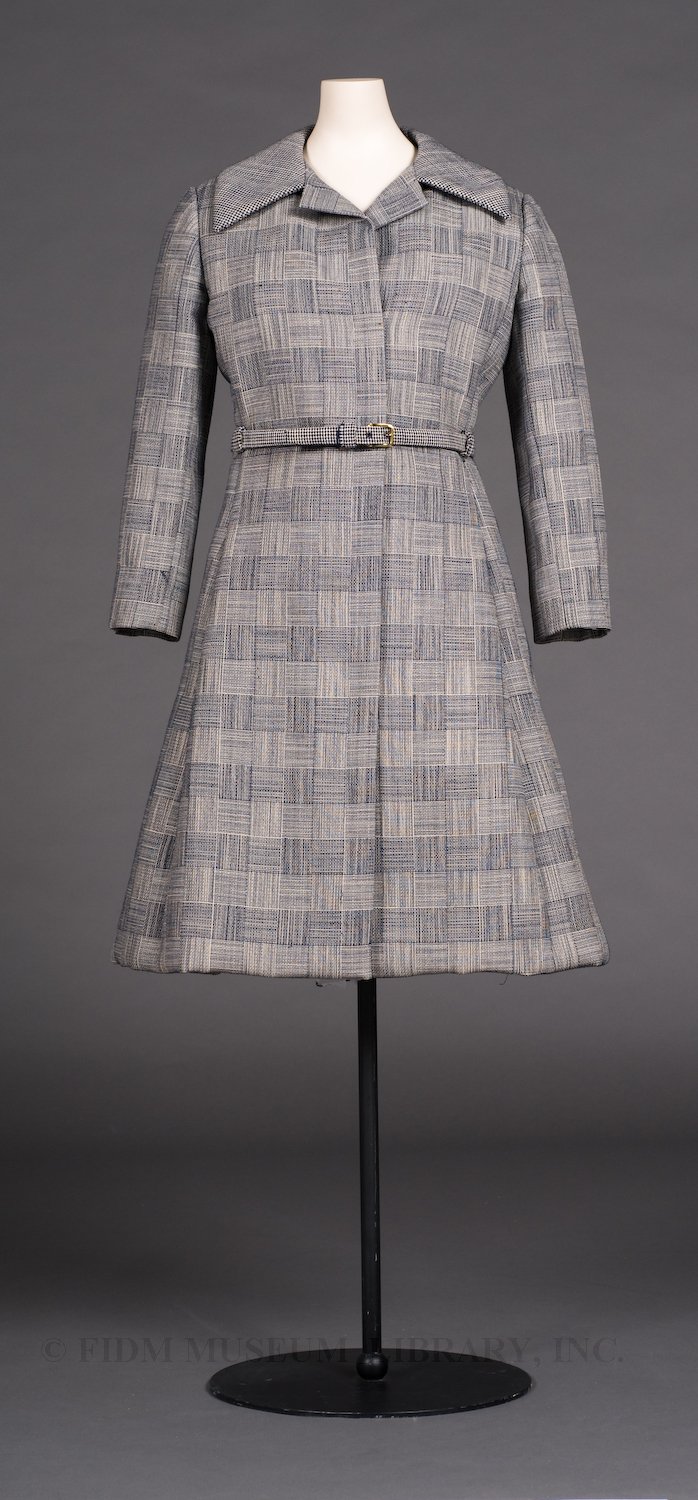Rhymes With Class
Yesterday, the venerable Bill Blass label was relaunched under the leadership of new creative director Chris Benz. Blass (1922-2002) revolutionized American sportswear, effortlessly blending Hollywood glamour with no-nonsense modernism. He merged simple styles with luxurious materials, such as a pea coat fashioned from white mink. Issey Miyake called him "the quintessential American designer."1 At a 1976 state dinner at the White House, President Gerald Ford introduced Blass to Queen Elizabeth II as "our king of fashion."2

Coat
Bill Blass
c. 1970
Permanent Collection
2004.40.15AB
This navy and white lattice-patterned wool coat with herringbone belt is typical of his casual sophistication. Blass dressed New York socialites and celebrities--including Jacqueline Kennedy Onassis, Nancy Reagan, Brooke Astor, Nan Kempner, Liza Minnelli, Babe Paley--in elegant, effortless clothes appropriate for charity galas and country club luncheons. He was one of the first American designers to move in the same circles as his moneyed clients, making regular appearances in the society pages. He wore Savile Row suits and amassed a collection of art and antiquities, much of which he left to the Metropolitan Museum of Art. According to the New York Times, "Bill Blass wasn't at the intersection of American fashion and society. He was the intersection."3
Blass was born and raised in Indiana; his mother was a dressmaker. He earned enough money sketching evening gowns for a Seventh Avenue manufacturer to put himself through Parsons School of Design.4 But his promising career was interrupted by World War II. Blass enlisted in the Army, where he was assigned to the 603rd Camouflage Battalion, or "Ghost Army." His design training helped him create inflatable tanks, dummy camps, and other visual and audio diversions to confuse the enemy.
Returning to New York in 1945, he worked behind the scenes for several major garment manufacturers. In 1970, he bought his employer, Maruice Rentner Ltd., and rechristened the company Bill Blass Ltd.--an unusual and risky move at the time. Over the years, the label expanded to include swimwear, furs, jeans, bed linens, eyewear, luggage, perfume, and even chocolates and a line of Ford Continental Mark cars, eventually holding 97 licenses generating $700 million a year. After suffering a mild stroke, Blass sold the business and retired in 1999. The following year, the lifelong smoker was diagnosed with cancer of the tongue. He died in 2002, just before his 80th birthday.
The label struggled to survive without him. Benz--also a Parsons graduate--is the sixth designer to attempt to fill Blass's shoes (others have included Michael Vollbracht, Lars Nilsson, and Peter Som). He's rebooting the brand with the help of the company's extensive archives, containing more than 1,200 garments plus photos, sketches, fabric swatches, letters, diaries, and other ephemera. In a break from the past, the clothes will be sold online only, and the selection will be updated continuously rather than presented on the runway as seasonal collections. As Blass himself once said: "There are only two seasons: hot and cold."5
*****
1Helen O'Hagan, Kathleen Rowold and Michael Vollbracht, Bill Blass: An American Designer (New York: Abrams, 2002), 42.
2Rick Beyer and Elizabeth Sayles, The Ghost Army of World War II (New York: Princeton Architectural Press, 2015), 231.
3New York Times, August 24, 1999.
4Bill Blass, Bare Blass (New York: Harper Collins, 2002), 6.
5New York Magazine, October 27, 2015, http://nymag.com/thecut/2015/10/chris-benz-is-out-to-reinvent-american-fashion.html.